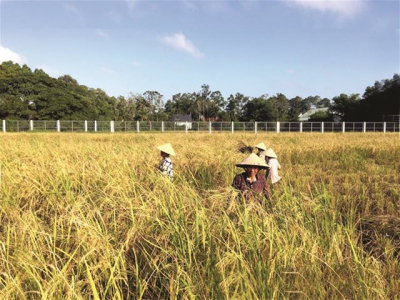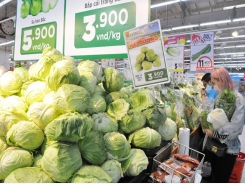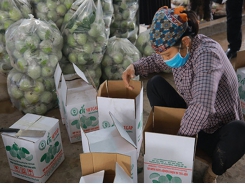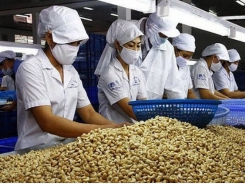Seasonal organic rice revival in Mekong Delta

A field of seasonal rice in the Mekong Delta
According to the analysis by QY Research published in 2020, the total value of global organic rice exports in 2018 was US$1.5 billion. The figure was forecast to increase 9% in the period 2019-2025 and reach US$2.78 billion by 2025. In Vietnam, seasonal organic rice, which has been seemingly extinct after some time, is gradually reviving and proving its outstanding value to farmers and the ecology.
In 2020, the Mekong Delta had over 1,400 hectares of rice in the provinces of Ca Mau, Soc Trang, Tra Vinh, Ben Tre, Kien Giang and Vinh Long which were certified up to the international organic standards (USDA/EU/JAS—U.S. Department of Agriculture/European Union/Japanese Agricultural Standards). Ca Mau had the largest area of organic rice-shrimp production. Meanwhile, the seasonal rice, the kind of seasonal floating rice grown without chemicals likely to be converted to organic certified rice, has begun to revive on the delta soil.
Before the short-term high-yield shennong rice was introduced into the Mekong Delta in 1964, the seasonal rice was cultivated in most rice farmland in the delta. In deep flooded areas like An Giang, Dong Thap, Tien Giang and the upstream districts of Long An Province, the seasonal floating rice was grown in more than half a million hectares of land. Before 1975, An Giang Province had over 250,000 hectares of seasonal floating rice. In low flooded areas like the downstream of An Giang, Dong Thap, Tien Giang, Long An and Can Tho, low flooded rice was grown, while in several coastal provinces like Kien Giang, Soc Trang, Ben Tre, Tra Vinh, Hau Giang, Bac Lieu and Ca Mau, mid-season rice was cultivated.
The cultivation system for the seasonal rice was very diverse. In deep flooded and flooded areas, farmers grew plants of the bean and the melon families after the seasonal rice harvest in the twelfth month of the lunar calendar. Meanwhile, the coastal areas were often left deserted because of the lack of freshwater in the dry season or were grown with grass for animal husbandry.
Long forgotten and nearly lost
The area of seasonal rice was gradually narrowed when the shennong rice was grown, gave high yield and had export markets. Vietnam turned from a rice importing country to a rice exporting country in the 1990s and then became the world’s top rice exporter over a long period of time. Thereafter, policies for investment in scientific research, hybridization, soil improvement and dealumnization of the Long Xuyen Quadrangle and the Plain of Reeds, the Mekong Delta’s rice basket, were focused only on the shennong rice development.
The seasonal rice was forgotten for a long time because it is a long-term rice strain with low yield, unable to meet the demand for national food security. In 2012, we (the research team from the Rural Research and Development Center with An Giang University) studied the seasonal rice situation in the Mekong Delta and found that the seasonal rice gene was preserved and the sustainable cultivation system was developed in the seasonal floating rice fields in some areas. An Giang Province had 41 hectares of seasonal floating rice in Tri Ton District and more than 30 hectares in Cho Moi District (in 2012), Dong Thap Province had 54 hectares in Thanh Binh District (in 2014) and the two villages of Nui To and O Lam in Tri Ton District had over 200 hectares of the nang nhen seasonal rice.
In upstream provinces like Long An, the seasonal floating rice was non-existent and only some areas grew the Cho Dao fragrant rice with less than 100 hectares. In Can Tho and Vinh Long, the seasonal floating rice was gone for a long time. In Soc Trang and Bac Lieu, the mid-season rice was grown by the Khmer farmers in Vinh Chau to get straws for the onion crop, while in Hong Dan District of Bac Lieu Province, the Mot Bui red rice was cultivated in the paddy-shrimp field. In Ca Mau Province, only Tran Van Thoi District bordering the U Minh Ha National Forest had the Tai Nguyen seasonal rice grown in paddy farms thanks to the province’s only irrigation which brought freshwater from the Quan Lo Phung Hiep Canal. In Kien Giang Province, the seasonal rice did not exist. In 2017, engineer Le Quoc Viet, head of the Agriculture and Rural Development Office in the province’s Chau Thanh District, grew the rice in two hectares of his farmland.
Efforts to revive the rice
In 2019, Mr. Viet cooperated with local farmers to expand the area of seasonal rice farming with varieties like Tau Huong, Trang Tep, Mong Chim, Mot Bui, Ba Bui and Chau Hang Vo, and raise freshwater blue lobsters, and then saltwater tiger shrimps after harvest in 52 hectares in Cu La Village and Vinh Hoa Phu Commune of Chau Thanh District.
In 2020, some localities began experiments with the seasonal rice and seasonal floating rice. Lang Sen in Long An Province was quite successful with 30 hectares. An Phu District of An Giang Province zoned 500 hectares for seasonal floating rice farming under the WB9 project.
Other localities were also facing difficulties in the conversion to seasonal rice farming. Kien Luong District of Kien Giang Province experimented with seasonal rice-fish farming in more than 10 hectares. Thoai Son District of An Giang Province also started experiment with three hectares of seasonal floating rice in 2017. Hong Ngu and Tam Nong districts of Dong Thap Province re-experimented with the seasonal floating rice but were not successful due to many subjective and objective reasons.
At present, the research team from the Rural Research and Development Center is the pioneer in studying the seasonal floating rice. We have started with the long-term research program for preservation and development of the seasonal floating rice system in An Giang and Dong Thap provinces and have cooperated with engineer Le Quoc Viet to study the seasonal rice cultivation system in Kien Giang Province. The research program, with 11 projects, is supported by international organizations and the scientific research funds from An Giang University and An Giang Department of Science and Technology
Lower yield but higher efficiency
The diversity of crops and farm animals is a very important factor to sustain the model of cultivation of seasonal rice in general and seasonal floating rice in particular. The cultivation of seasonal floating rice combined with crops and husbandry gives persuasive results. After two to three years of execution of the project, we have examined the economic efficiency of the model, with the results presented in the table below. The model of farming seasonal floating rice combined with some crops (red pepper, glutinous corn, baby corn, cassavas and scallion) and meat cow breeding gives much higher income per 1,000 square meters of land than two or three high-yield rice crop farming. In particular, seasonal floating rice plus scallion farming can bring a profit of up to VND24 million per 1,000 square meters of land per year, while two-rice-crop farming gives only VND2.4 million and three-rice-crop farming VND4.8 million per 1,000 square meters of land per year. Seasonal floating rice plus red pepper or corn farming gives quite a good profit, second only to seasonal floating rice plus scallion farming. Seasonal floating rice plus cassava farming gives higher profit than three-rice-crop farming. The rates of returns of seasonal floating rice plus red pepper and seasonal floating rice plus cassava farming are higher than those of other cultivation models.
When seasonal rice and seasonal floating rice was revived, we found many field fishes which had come back to live, such as snakehead fish, anabas, catfish, mystus and mud carp, and other aquatic plants and animals which are products for locals during the flooding season. Alluvium was brought to the field, helping improve the soil from seasonal floating rice farming.
The rebirth of seasonal rice market
Local consumers, especially those in the South, have begun to get re-familiarized with the names of seasonal rice and seasonal floating rice. Before the seasonal floating rice preservation project started in early 2013, farmers in Tri Ton District of An Giang Province sold rice to locals through seasonal intermediaries. Upon the harvest season, sellers contacted buyers through telephone, set the harvest date and the rice was brought to the warehouse for consumption throughout the year. Some bought several hundred kilos or one ton of paddy for consumption all the year round.
When the project was developed in 2013, many consumers learned about it and the seasonal rice was sold in the first harvest in January 2014, with the price of VND14,000 per kilo at the field and VND15,000 per kilo in the following years. Cooking Studio, an enterprise from HCMC, has paid VND15,000 for a kilo of fresh rice, and processed, packaged, promoted and sold it for VND95,000 per kilo at the supermarket in the Phu My Hung urban center since 2016. In 2020, the company bought more than five toms of fresh seasonal paddy grown in the area under the project.
Early this year, the seasonal floating rice in Tri Ton District of An Giang Province was bought at the field for VND18,000 per kilo by Loc Troi Group, three times as much as the price of high-yield rice. The group has plans to promote the brand for seasonal floating rice in the Mekong Delta this year, giving an opportunity for expansion of the area for preservation and development of this special rice of the delta.
Besides the seasonal floating rice, the seasonal rice varieties of Tau Huong, Trang Tep, Mong Chim, Chim Roi, Mot Bui, Ba Bui and Chau Hang Vo have also been revived successfully by engineer Le Quoc Viet and have reached consumers at vegetarian and eco-restaurants in the Mekong Delta and HCMC through the connection program of Mekong Organics in Australia. Consumers have also known about the rice and placed orders with engineer Viet.
Products with added value from the seasonal floating rice are being studied under the Rufford project by Mekong Organics and Mekong Nutrition in An Giang for processing rice noodles and rice flour for marketing in Vietnam and Australia.
Related news
Tools

Phối trộn thức ăn chăn nuôi

Pha dung dịch thủy canh

Định mức cho tôm ăn

Phối trộn phân bón NPK

Xác định tỷ lệ tôm sống

Chuyển đổi đơn vị phân bón

Xác định công suất sục khí

Chuyển đổi đơn vị tôm

Tính diện tích nhà kính

Tính thể tích ao




 As pepper prices fall, experts urge farmers to…
As pepper prices fall, experts urge farmers to…  Cashew exports surge 46% over two months
Cashew exports surge 46% over two months